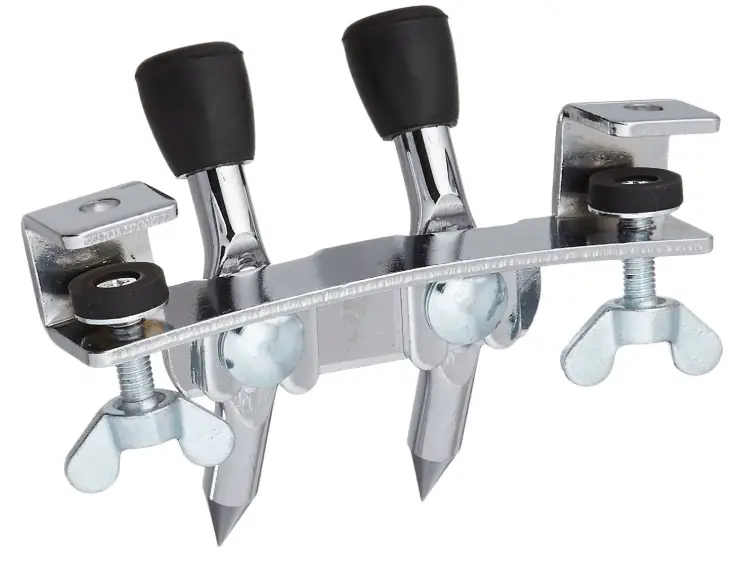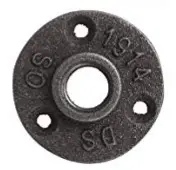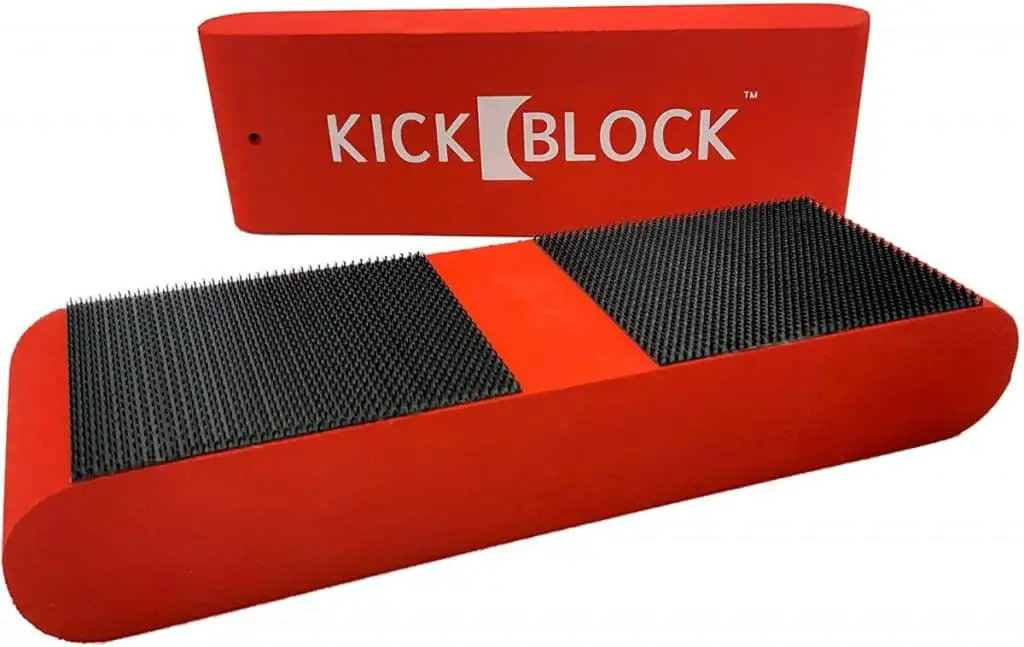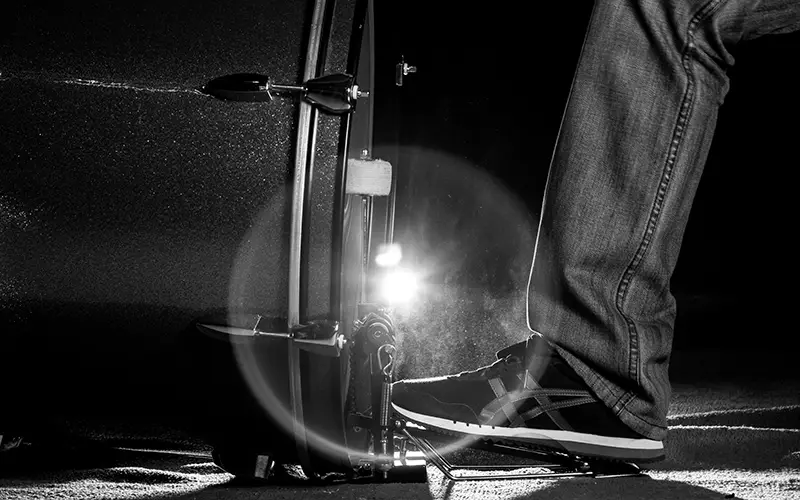
Fun Fact: Bass drums tend to creep forward while you’re playing them. It’s a frustrating truth of being a drummer and if you have spent any time behind a drum set at all, even if it’s just to mess around, you will likely have encountered this problem before.
These 11 simple solutions will help you keep your bass drum and anything mounted on top of it from moving forward while you play:
- Drum rug or carpet
- Bass drum spur adjustment
- Rubber/Neoprene
- Velcro
- KBrakes
- Drum Brakes
- Bass drum anchor
- Kick Strap
- DIY Metal Floor Flange or Pedestal Rings
- DIY Rope or Chain Strap
- Random heavy stuff (RHS)
- BONUS: KickBlock
What follows is a detailed description of each method described above. Depending on your situation, there are likely to be a few of these options which will work wonders for you. There are lots of products available on the market to solve this problem, all of which I will describe here. But there are also plenty of ‘free’ options to keeping your bass drum secure, especially if you have that DIY spirit.
1: Drum Rug or Carpet
Setting your drum set up on a rug in order to solve ‘bass drum creep’ is by far the most common solution to the problem as they are readily available and tend to be quite an effective solution. It shouldn’t come as a surprise when you see drummers carrying rugs around with their drum sets, or borrowing the piece of carpet from the entry way of the bar they are playing that night.
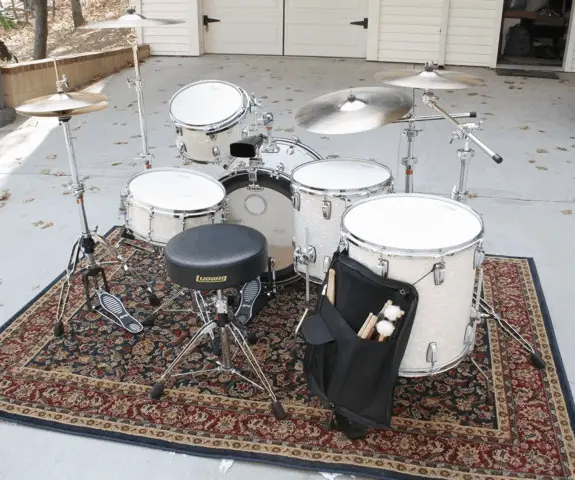
Additionally, many bass drum pedals also come with spikes which can be adjusted to provide additional creep stoppage.
There are a handful of products out there which cater specifically to this problem. Some of them have some innovations built in to them which help provide additional support for your kit. In my opinion however, I feel that these are typically over-priced pieces of carpet with the manufacturer’s logo on them.
In this area, I would actually recommend getting a piece of carpeting from your local hardware store (be careful not to get high pile carpet), an extra rug you might have hanging around the house, or one of those commercial rugs you see which has a rubber bottom and a very short, woven top. The size of this carpet at a minimum should be large enough so that both bass drum spurs AND at least two legs of your drum stool are on the carpet. It is not essential for the rest of the kit to be on the carpet as well.
Top Tip: If you’re feeling extra crafty, you can insert some grommets into your rug where the bass drum spurs are usually positioned. These metal grommets can be found at your local hardware store and are relatively easy to install. This will effectively anchor your bass drum to the carpet, much the floor mats of a car are secured with a little hook to prevent them from sliding up into the accelerator pedal.
Give this a try and let me know how it works out for you!
2: Bass Drum Spur Adjustment
Practically all bass drums have spurs (or legs) on either side of the instrument. These spurs can be configured in one of two ways:
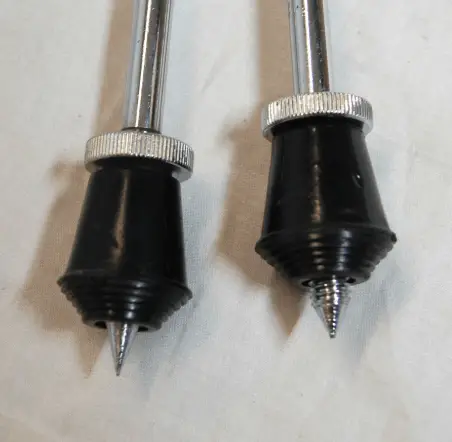
- Rubber Feet: Intended for use on smooth surfaces like concrete or laminate, setting your spurs up with the rubber tips helps provide grip on non-carpeted surfaces. In my experience, this generally doesn’t work very well.
- Spiked Feet: Alternately, you can set your bass drum spurs up with spikes protruding from the ends. These spikes tend to do a pretty good job on top of a rug to prevent the bass drum from creeping forward.
The adjustments mentioned above are accomplished by screwing the rubber foot up or down the leg of the spur. When the rubber foot is screwed up onto the spur, the spike is exposed at the end and vice versa.
I would recommend experimenting with this adjustment a bit as the surface you are setting your drums up on will dictate this adjustment.
3: Rubber/Neoprene
This solution (as well as the next one) are really more geared towards the actual bass drum pedal than the drum itself because there isn’t enough surface area of a bass drum that comes in contact with the ground in order for this to work on the drum.
A lot of bass drum pedals come with a metal plate on the bottom and some already come with some rubber strips attached to the underside. It is my experience however that these strips don’t really do much to prevent your bass drum from sliding across a slick floor.
I’ve purchased sheets of neoprene rubber before and adhered them to the pedal board with 3M double sided adhesive tape. This is solution is quite effective on smooth surfaces and does help on carpeting as well.
before and adhered them to the pedal board with 3M double sided adhesive tape. This is solution is quite effective on smooth surfaces and does help on carpeting as well.
4: Velcro
Much like the ‘Rubber’ solution above, this solution is much more geared towards the bass drum pedal itself than the actual drum. To take it a step further though, velcro is quite useful for just about any pedal, whether it be on a hi-hat stand or the slave of a double bass drum pedal.
The reason for this is that Velcro is made up of tiny little plastic hooks which are specifically designed to adhere to material much like carpet. As such, if you are playing on top of a carpeted surface, the ‘stickiness’ of the velcro itself will likely be enough to keep your instruments in place.
I should note that velcro isn’t necessarily an effective solution for smooth surfaces however as it is definitely not designed to grip floors like concrete.
My recommendation here would be to get some heavy duty velcro much like this , cut it to the same shape as the floor plate of your pedal and use the adhesive backing to tack it in place. You can provide additional security here by using the screws that hold the pedal onto the plate as additional anchors for the Velcro.
, cut it to the same shape as the floor plate of your pedal and use the adhesive backing to tack it in place. You can provide additional security here by using the screws that hold the pedal onto the plate as additional anchors for the Velcro.
Critical: As you probably know, Velcro comes with two sides, a harder side and a softer side which feels more like fabric. Don’t use the ‘softer’ side as this isn’t the piece that is designed to adhere to carpeting. You’ll want to use the harder plastic side of the velcro.
5: KBrakes
I have to admit that I think this option is pretty slick. KBrakes are a relatively new product on the market and do an effective job of stopping a kick drum in its tracks.
are a relatively new product on the market and do an effective job of stopping a kick drum in its tracks.
They are essentially flat bottomed ‘boots’ with roughly 500 tiny spikes on them which you attach to the end of your spur. Because there is more surface area in contact with the carpeting, there is much less tendency for the bass drum to start creeping away.
At $40/pair , they aren’t the cheapest solution on the market, but tend to be one of the most effective products attempting to solve this age-old problem, and the positive reviews you’ll find for KBrakes means that others are seeing success with them as well.
, they aren’t the cheapest solution on the market, but tend to be one of the most effective products attempting to solve this age-old problem, and the positive reviews you’ll find for KBrakes means that others are seeing success with them as well.
KBrakes also offers an additional smooth surface anchor onto which the KBrake can be attached. This is intended for smooth surfaces, which is great for anyone looking for versatility. I think this is fantastic news however I have not personally tried this add-on, so I can’t speak to their effectiveness. At $20/pair, it’s probably worth trying though.
onto which the KBrake can be attached. This is intended for smooth surfaces, which is great for anyone looking for versatility. I think this is fantastic news however I have not personally tried this add-on, so I can’t speak to their effectiveness. At $20/pair, it’s probably worth trying though.
All in all, I’m a fan of KBrakes. Do I think they are an absolute must have? Probably not to start with…but once a drummer starts gigging a whole lot, there are all sorts of setup scenarios which might necessitate a versatile product like this one.
6: Drum Brakes
Update: Since I first published this article in 2020, this product appears to no longer be available. I have kept it in as the website is still active, however there doesn’t appear to be an option to purchase.
Drum Brakes (not to be confused with KBrakes) are small, circular anti slip pads which can be placed strategically under various components of the drum set to eliminate slipping.
(not to be confused with KBrakes) are small, circular anti slip pads which can be placed strategically under various components of the drum set to eliminate slipping.
Their claim is that it eliminates the need for a drum rug altogether so that you can play on those awesome hardwood floors that you just had put in.
At $20 for a 4 pack, it might be cheaper to go with another solution as you’ll likely need 2-3 packs of them to secure everything, especially if you’re a hard hitter.
I think that this is a perfectly viable solution for someone who has their kit set up at home and doesn’t move it much. I probably wouldn’t recommend this solution for anyone who is constantly moving their drum set from place to place and gig to gig, as they will likely not withstand that abuse (or stay very clean for that matter).
7: Bass Drum Anchor
These anchors have been around forever and can be a pretty effective hardware solution to the issue. A drum anchor (Usually ~$10/each) is a bracket which is affixed to the front hoop of the bass drum and has both rubber and spiked feet which protrude out the front. It essentially adds another pair of spikes or rubber feet to your bass drum.
(Usually ~$10/each) is a bracket which is affixed to the front hoop of the bass drum and has both rubber and spiked feet which protrude out the front. It essentially adds another pair of spikes or rubber feet to your bass drum.
The idea here is that the force of these feet mounted at the front of your bass drum is enough to offset the force caused by your playing. Much like other solutions I’ve listed here, these anchors definitely necessitate the use of a drum rug in conjunction with the anchor.
8: Kick Strap

Kick Strap was invented by a guy named Gary Benson and consist of an adjustable cargo strap with a couple of specialized hooks on each end. One end is attached to the base plate of your bass drum pedal, while the other end hooks onto the center post of your drum throne.
was invented by a guy named Gary Benson and consist of an adjustable cargo strap with a couple of specialized hooks on each end. One end is attached to the base plate of your bass drum pedal, while the other end hooks onto the center post of your drum throne.
These can also be used for hi-hat stands and double bass drum pedals. All in all, Kick Straps amount to a very effective and unique solution to the problem and at $30/each is right in line with some of the other products out there.
9: DIY Floor Flanges, Blocks or Pedestal Rings
Your creativity can go wild with this suggestion, as there are many ways you could go about doing this. While I will give you a couple of suggestions here, what this solution amounts to is this:
Go raid your local hardware store for items which can be mounted to your drum rug in strategic places to keep your drums and hardware in place.
As I mentioned, you’re really only limited to your imagination here, but here are a couple of examples to help spark your imagination:
including using small pieces of 2×4 and some bolts, nuts and washers. Another option here would be to look for some sort of metal bar which you could attach to the rug in a similar fashion.
- Floor Flanges
 for iron pipes mounted to the rug are another cool option, borrowing from the plumbing industry. In this scenario, your bass drum legs would rest in the center, threaded section of the flange.
for iron pipes mounted to the rug are another cool option, borrowing from the plumbing industry. In this scenario, your bass drum legs would rest in the center, threaded section of the flange. - I found some Pedestal Rings
 which are used in the marine industry, which would make for a decent bass drum stopper
which are used in the marine industry, which would make for a decent bass drum stopper - Small blocks of a 2×4 fastened to the rug with some bolts, nuts & washers
- Metal bar or angle iron attached in a similar fashion
Again, roaming the aisles of your local hardware store will likely produce a list of additional options for anchoring your kick drum to a rug or riser.
Added bonus:
This solution permanently marks the location of the components you are anchoring, making setup easily repeatable and super quick!
10: DIY Rope or Chain Strap
Kick Straps (mentioned above) are definitely a great pro solution. For those on a budget however, a long-ish piece of rope and or chain might just do the trick as well.
By running the rope from one bass drum spur (where it will be fastened or tied), around the center post of your drum throne and then back to the other bass drum spur, you have effectively created yourself an anchor which uses your weight sitting on the stool to keep your bass drum from moving.
Using metal chain for this gives you a slightly better solution as there won’t be a need to tie or fasten the end to each spur. Instead, you’ll simply insert each spur’s spike down through the last link in each end of the chain before running it around the drum throne.
The only tricky bit here is to ensure you have exactly the right length of rope or chain for this purpose. Too loose and your bass drum will move. Too tight and you’ll be sitting too close for comfort to the drum set. This is another reason why a chain might be preferable here because once you have the length nailed down, it will take the guess work out of where to place it.
11: Random Heavy Stuff (a.k.a RHS)
There really isn’t much to this solution to the problem, other than placing heavy objects in front of your bass drum. You probably wouldn’t want to use this in any kind of performance scenario, but for practicing at home or with a band, it should do just fine.
Some examples I’ve seen for this include:
- Sand bags (those used in film and audio to secure stands)
- A cinder block or two (might damage the front of the hoop)
- Your bass player’s speaker cabinet
- A small child (just kidding – please don’t do that)
The ultimate heavy object: A wall! If you’re playing in the comfort of your own home, why not just set your drum kit up so that you are facing a wall and using it to prevent the bass drum from exiting your general vicinity.
12. BONUS: KickBlock
I decided to add KickBlock to this list as #12 because it recently won my YouTube product shootout on carpeted kick drum anchors! It is a fantastic and super simple product which works via heavy duty velcro that firmly attaches to your drum rug and keeps the drum from moving forward. Simple, affordable and insanely effective!
to this list as #12 because it recently won my YouTube product shootout on carpeted kick drum anchors! It is a fantastic and super simple product which works via heavy duty velcro that firmly attaches to your drum rug and keeps the drum from moving forward. Simple, affordable and insanely effective!
UPDATE:
Since I first wrote this article, I’ve also started a YouTube series on this topic of how to keep a bass drum from sliding. Click on the thumbnail below to view the first in my 3-part series on bass drum anchors:
Related Questions
Can I just put my bass drum on the carpet that’s already installed on the floor? Technically, yes that will work to prevent the bass drum from moving. That said, after many hours of practice, the carpet itself is likely to have irreversible damage done to it. It’s best to protect it with some sort of rug, or even some plywood.
How can I make sure that I am sitting properly behind my drumset? Proper posture behind the drums starts with the relationship to you, your throne, bass drum, snare drum and hi-hat. I wrote an entire article about how to properly set up your throne so that you are sitting correctly behind your kit.
so that you are sitting correctly behind your kit.



